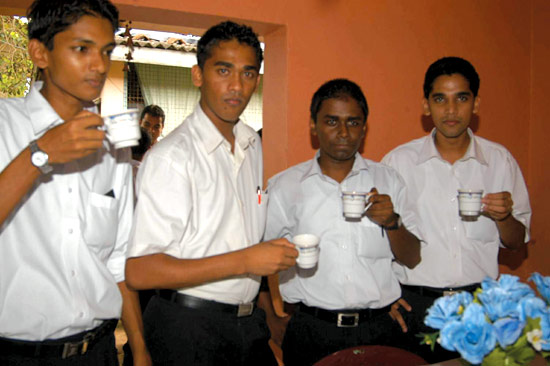Orthodox leafy tea fetches premium price - Anil Cooke
Lanka carves niche in global market:
by Surekha GALAGODA
[email protected]
Sri Lanka has carved a niche in the global market for specialty
orthodox black tea as the country has continued and developed the
traditional style of black tea manufacture for more than hundred years.
|

The cup that cheers |
Today discerning consumers looking for high end teas such as Orthodox
Ceylon’s are willing to pay a premium price for it, said President/CEO
Asia Siyaka Commodities (Pvt) Ltd Anil Cooke.
He said that Orthodox leafy tea production is accelerating in the
country with even high grown areas moving towards leafy tea manufacture.
Unlike in the past when high grown varieties of tea accounted for the
bulk of national production; today low country teas account for 55% of
all teas produced in the country.
Ceylon Tea is now more than its traditional range of fine tasting
teas. It extends to some of the finest specialty black tea grades and
even fine green teas.
He said that other black tea producing nations have been studying the
trends and many countries are trying to expand orthodox manufacture.
Therefore, we have to raise the bar, so that imitation and substitution
becomes difficult.At present the country produces 14 grades of orthodox
tea in 36 different growing regions.
Sri Lanka’s strength as the leading orthodox black tea nation is
supported by its globally recognised brand Ceylon Tea and the Lion logo.
He said that earlier consumer loyalty was for the country of origin,
but larger international packers changed this to a brand based identity.
With brand loyalty growing, packers dropped references to origin. Today
a growing number of consumers want to know what they are paying for.
They are also looking for more choices of taste and style and there
is a growing awareness and demand for teas from different regions and
single estate teas. Sri Lanka’s 36 sub districts, three elevations, two
quality seasons and range of orthodox grades, are ideally positioned to
meet this market trend.
Sri Lanka’s tea producers are investing heavily on new technology
while upgrading the factories and systems. Being aware of the growing
trend of consumer preference for healthier products and ethically
produced goods Sri Lanka has led the way with the introduction of HACCP
and ISO standards.
The strong legal framework maintained by the Sri Lanka Tea Board and
high standards set and monitored by our Tea Research Institute has added
credibility to our tea. This then could be the next standard for
quality.
The challenges faced by producers are many. Sri Lanka is one of the
high cost producers in the world. Recent global trends such as the
escalating oil prices, increasing cost of electricity and continuous
wage demand have added to this burden. For tea producers it is a
continuous challenge to increase their prices, as many of the cost
components are beyond their control.
He said that despite these constraints the high and steady
reinvestment in technology, agricultural practices and factory
development are positive features that are laying a strong platform for
the future.
CEO Richard Peiris Plantation Group Ravi Kumararatna said that
earlier 20-30% of Sri Lankan tea was exported to the UK. Today it is
less than 5% while 80% of our tea is purchased by the Middle East and
Russia.
The type of teas consumed are leafy teas in brewed form and tea bag
consumption is not as developed in these markets. Sri Lanka’s leafy teas
were originally produced in the low grown areas but now these varieties
are produced in the mid and high grown regions as well and they fetch a
premium price.
Today the largest tea producing areas are Ratnapura, Galle, Matara
and Deniyaya; all manufacturing orthodox black tea.
Middle East and Russia are largely brewed tea drinkers and the Middle
East can afford to pay a higher price as they have petro dollars.
He said that even in the US, though the market was mainly a Ready To
Drink tea market made from tea essence they now drink brewed iced tea.
Today only the traditional markets in the west drink small leaf mid and
high grown teas.
The global economy has changed and the Middle East is a big tea
drinker. Seeing this opportunity other producer countries such as India
and Vietnam are exploring the possibility of reverting to producing
leafy teas. |
